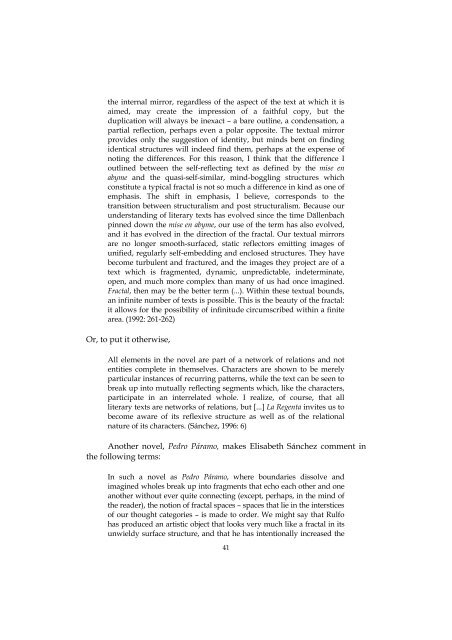translation studies. retrospective and prospective views
translation studies. retrospective and prospective views
translation studies. retrospective and prospective views
Create successful ePaper yourself
Turn your PDF publications into a flip-book with our unique Google optimized e-Paper software.
the internal mirror, regardless of the aspect of the text at which it is<br />
aimed, may create the impression of a faithful copy, but the<br />
duplication will always be inexact – a bare outline, a condensation, a<br />
partial reflection, perhaps even a polar opposite. The textual mirror<br />
provides only the suggestion of identity, but minds bent on finding<br />
identical structures will indeed find them, perhaps at the expense of<br />
noting the differences. For this reason, I think that the difference I<br />
outlined between the self-reflecting text as defined by the mise en<br />
abyme <strong>and</strong> the quasi-self-similar, mind-boggling structures which<br />
constitute a typical fractal is not so much a difference in kind as one of<br />
emphasis. The shift in emphasis, I believe, corresponds to the<br />
transition between structuralism <strong>and</strong> post structuralism. Because our<br />
underst<strong>and</strong>ing of literary texts has evolved since the time Dällenbach<br />
pinned down the mise en abyme, our use of the term has also evolved,<br />
<strong>and</strong> it has evolved in the direction of the fractal. Our textual mirrors<br />
are no longer smooth-surfaced, static reflectors emitting images of<br />
unified, regularly self-embedding <strong>and</strong> enclosed structures. They have<br />
become turbulent <strong>and</strong> fractured, <strong>and</strong> the images they project are of a<br />
text which is fragmented, dynamic, unpredictable, indeterminate,<br />
open, <strong>and</strong> much more complex than many of us had once imagined.<br />
Fractal, then may be the better term (...). Within these textual bounds,<br />
an infinite number of texts is possible. This is the beauty of the fractal:<br />
it allows for the possibility of infinitude circumscribed within a finite<br />
area. (1992: 261-262)<br />
Or, to put it otherwise,<br />
All elements in the novel are part of a network of relations <strong>and</strong> not<br />
entities complete in themselves. Characters are shown to be merely<br />
particular instances of recurring patterns, while the text can be seen to<br />
break up into mutually reflecting segments which, like the characters,<br />
participate in an interrelated whole. I realize, of course, that all<br />
literary texts are networks of relations, but [...] La Regenta invites us to<br />
become aware of its reflexive structure as well as of the relational<br />
nature of its characters. (Sánchez, 1996: 6)<br />
Another novel, Pedro Páramo, makes Elisabeth Sánchez comment in<br />
the following terms:<br />
In such a novel as Pedro Páramo, where boundaries dissolve <strong>and</strong><br />
imagined wholes break up into fragments that echo each other <strong>and</strong> one<br />
another without ever quite connecting (except, perhaps, in the mind of<br />
the reader), the notion of fractal spaces – spaces that lie in the interstices<br />
of our thought categories – is made to order. We might say that Rulfo<br />
has produced an artistic object that looks very much like a fractal in its<br />
unwieldy surface structure, <strong>and</strong> that he has intentionally increased the<br />
41












